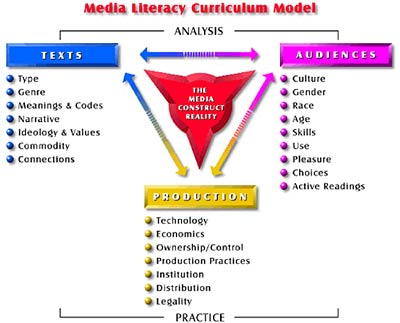“What’s The Story?”
Using Media Literacy to Develop Critical Thinking
Presented by Maxine Einhorn
KQED Project Supervisor
415-553-2402
meinhorn@kqed.org
Objectives:
• To illustrate the power of the media in the lives of educators and students
• To establish media literacy as an instructional strategy for developing critical thinking in students
• To provide educators with a framework for critical media literacy
• To introduce KQED media and online resources
1. Introductions
2. What is critical thinking? Why is it important?
What is media literacy? Why is it important?
3. Media Literacy Framework – MAP
4. Demonstrating the approach using Please Vote For Me – Independent Lens – KQED media extract
• What is this trailer saying to us?
• How do the images and visual effects work?
• As viewers what do you bring to this text?
• How might you use this in your teaching?
5. Demonstrating the approach using contrasting genres.
Critical questions handout
6. Pedagogical strategies for promoting critical media literacy
7.Resources + website
Media literacy resources: http://www.kqed.org/education/digitalmedia/media-literacy.jsp
Definitions of Media Literacy
According to the Center for Media Literacy, a new vision of literacy for the 21st Century includes:
“the ability to communicate competently in all media forms, print and electronic, as well as to access, understand, analyze and evaluate the powerful images, words and sounds that make up our contemporary mass media culture. Indeed we believe these skills of media literacy are essential for both children and adults as individuals and citizens of a democratic society.”
According to the National Association of Media Literacy Education:
“The purpose of media literacy education is to help individuals of all ages develop the habits of inquiry and skills of expression that they need to be critical thinkers, effective communicators and active citizens in today’s world.”
Critical Thinking – Key Ideas
A critical thinker is able to:
• Distinguish between reasoning and subjective reaction
• Suspend judgment
• Engage in rational discussion and argument
• Base reasoning on evidence
• Offer criteria on which to base judgments
• Employ skills such as communication skills, problem solving and creative thinking
• Demonstrate self esteem i.e. confidence in one’s thought process
From: Critical Thinking by Richard Paul
Using Media in the Classroom
Media are valuable tools when used interactively and integrated well into the curriculum.
Media can:
• Enhance concepts and stimulate students’ imagination
• Provide students with access to a variety of people and ideas
• Reach students with a variety of learning styles
• Illustrate complex, abstract concepts through animation
• Sharpen students’ critical thinking, language, and inferential skills
• Model experiments, language, or scenes from history and literature
• Promote analysis and discussion
• Instigate problem-solving and investigation activities
• Dismantle social stereotypes
Utilization techniques
1. Preview each program. Decide on the lesson’s objectives and the students’ learning outcomes.
2. Select Segments that are most relevant to the lesson topic. Often a program has a great deal of information that cannot be digested at once; in that event, show the program in segments so that its content can be more easily understood. Sometimes a couple of minutes are all you need.
3. Provide a Focus for Viewing – ask students to:
• Answer a question
• Look for something specific
• Note down unfamiliar vocabulary
• Engage in an activity that will clarify the program’s content or meaning
• Follow-up with a discussion or an activity after viewing the DVD
4. Conduct Pre- or Post-Viewing Activities. Activities prior to viewing the clip can:
• Introduce the topic
• Provide background information and context
• Identify new vocabulary words
• Review, reinforce, apply, or extend the information conveyed by the program
• Link to lesson and curriculum objectives
5. Pause while viewing to check students’ comprehension, ask questions, have students record information, make predictions, analyze what they’ve seen, examine a chart, formula, or image on the screen more closely, or have the students draw a diagram. Again, it’s important to make the viewing as interactive as possible.
6. Eliminate either the sound or the picture. Turn down the volume and provide your own narration. Another strategy is to eliminate the sound and have your students describe the images they see.
Alternatively, you can isolate the soundtrack by covering the monitor, and have your students guess what is happening based on the narration alone.
Basic Media Education Questions
When using media in the classroom it is helpful to ask some basic questions that will expand your students’ understanding of the information they are receiving. Soon these questions will become the standard inquiry around any media, inside and outside the classroom, empowering your students to be more savvy media consumers and creators.
What is the message? Who made it? Why was it created?
Who is the target audience? How do you know?
How was it made? Why was it made that way?
What is the context in which it was created?
How might this media impact you, your community and our society?
How/why might different audiences interpret this message differently?
How could it be different? What is missing? Is this fact or fiction?
Why do they use __________________ (an interview, graphics, pictures, music, etc) instead of another way to communicate information? How are graphics used?
What is the role of the ____________ (narrator, character, anchor etc.)?
How is music used?
MAP Framework
This Media Literacy Curriculum Model is based on the critical framework developed by Eddie Dick of the Scottish Film Council.
http://www.media-awareness.ca/english/resources/educational/teaching_backgrounders/
media_literacy/perfect_curriculum_1.cfm
<!–[if gte vml 1]> <![endif]–><!–[if !vml]–><!–[endif]–>
Critical Analysis of a Visual Text
Look closely at ………………………… noting down key ideas, thoughts and responses.
Respond to the following questions.
Message
• Describe what you see in as much detail as possible
• What/who is represented? How?
• What is this video extract saying – message, key ideas, title etc?
• What is the context?
• What associations or ideas are suggested?
Audience
• Who is the intended audience? Is there one?
• Why might different people respond differently to this text?
• Does it evoke controversy?
Production/Purpose/Intention/Stylistics
• Who produced this image? Why? Is it important to know this?
• What, in your view, is the purpose or intention of this text?
• Is it funny or amusing to you?
• What devices are used to capture your attention?
• Do the images offer a visual argument/in what ways?
Focus On Audience – Activity
1. Working in pairs, share your responses and consider the ways in which your ideas
are the same or different.
2. Why might different people respond differently to this text? What factors shape response?
3. Think about the following factors and how they impact responses to this media extract text:
background knowledge, cultural context, religion, social background, gender, ethnicity, age.
Key Concepts of Media Education
(Reprinted from Media Literacy Resource Guide: Intermediate and Senior Division. Toronto:
Ontario Ministry of Education, 1989.)
1. All media are CONSTRUCTIONS:
Media are mediated communication. They are not “slices of life,” “windows on the world,” or “mirrors of society.” They are carefully manufactured constructs with nothing left to chance. They are not, by definition, “real,” although they attempt to imitate reality. The success of these manufactured constructs lies in their apparent naturalness. Our job as media educators is to make media “strange” and problematic to students.
2. All media construct REALITY:
Although media are not real, they can shape our attitudes, behavior and ideas about the world. The WWII broadcaster, Walter Lippman called it “the world outside and the pictures in our heads.” If we haven’t had first-hand experience with a person, place or thing and yet we feel we know something about it based on media information, then media has constructed a form of reality for us. Our job as media educators is to question media culture and to teach our students to think about reality vs. mediated information.
3. AUDIENCES negotiate meaning in media:
Audiences are not passive entities. We may look passive as we sit motionless in front of a book or a TV, but our minds are working to make sense of the information. This is especially true of fast-paced modern media. We learn to anticipate the codes and conventions in media and to somehow “read” or make meaning of its message. We do this as individuals and in predictable ways, as groups. Our taste in media content and forms changes as we age. Advertisers know this and try to target us as individuals and as audiences. Our task as media educators is to help students become aware of the way that they interact with media personally, and to speculate about the way that others might use media.
4. Media have COMMERCIAL implications:
Media industries add billions of dollars to economies and are one of the United States’ largest exports. In addition to the business generated by media commodities, spin-off products and services that rely on media industries generate billions more. Commercial factors such as distribution, technical costs, labor costs ownership and potential ad sales influence content. Advertisers are guaranteed a number of consumers who will see their ads and who they target to buy products. Advertising drives media businesses. The commodity that is bought and sold is the audience. Our challenge as media educators is to educate students about media industries and the way that they are intertwined with modern economic systems. We can teach students to question the economic decisions that influence the content of a media product and to become aware of the place of media industries in the overall economy.
5. Media contain IDEOLOGICAL and VALUE messages:
Objectivity and balance are journalistic ideals, but media are not value-free. The notion of objectivity in media is a relatively new idea. Until the first part of the Twentieth Century, audiences did not expect media to be objective. They knew the “Republican” newspapers or the “Democrat” magazine and generally bought them according to their own ideological persuasion. Media content that purports to be objective can hide explicit and implicit values and ideology. Most modern media content maintains a social status quo or “sells” a consumer lifestyle. The role of the media educator is to guide students to uncover ideological messages using media literacy techniques and values education strategies.
6. Media have SOCIAL and POLITICAL implications:
Media have irrevocably altered the landscape of modern political campaigning. Media not only seek to sell us products, but they also sell us political candidates, ideas, public health messages, and seek to shape audiences into political constituencies. Media technologies have altered our culture, our families and the way we use our leisure time. Although they may not directly affect the way we behave, media seek to legitimize and reinforce social and political behavior. The job of the media educator is to increase students’ awareness about the political and social messages in media and the way they seek to shape political and social attitudes.
7. Media have UNIQUE AESTHETIC FORM – closely related to CONTENT:
People derive great pleasure from their use of media and media literacy skills can heighten that pleasure. We can appreciate the artistry of texts, technical feats, and creative vision. We can also understand that form and content are closely related in media and that each medium has unique codes, conventions, benefits, and limitations that influence its content. Students can learn creative self-expression by producing their own media texts in the classroom, as they analyze the texts of others. They can also see how each medium reports the same event in a different way due to the constraints and limitations of the medium.
Pedagogical Strategies for Promoting Critical Thinking
1. Support students in identifying assumptions and emotionally charged vocabulary
2. Encourage students to distinguish between gut reactions, as opposed to
thought-out arguments and opinions
3. Start with students’ knowledge, perceptions, and misconceptions
4. Use open ended and probing questions
5. Encourage skepticism of “authority” and claims to knowing correct answers
6. Be concise and avoid talking too much to encourage students to think more
7. Encourage students to process information rather than regurgitate it
8. Ask students to reflect upon their own thinking process
9. Use collaborative learning strategies
10. Model how to think through problems
11. Provide time for reflection and analysis
12. Play devil’s advocate; explain how taking an opposite point of view can clarify thinking
13. Demonstrate respect for other viewpoints
14. Demonstrate that it’s OK to change your mind based on new information
15. Encourage critical thinking without forcing it
16. Do not present information didactically. Let students research different
viewpoints and analyze texts
17. Encourage role play to promote dialogue between different views
18. Focus on fundamental concepts with general applicability

 Canvas
Canvas
 Donate
Donate
 Let's Talk!
Let's Talk!



Comment section
1 thought on “KQED Media Literacy”
Comments are closed.